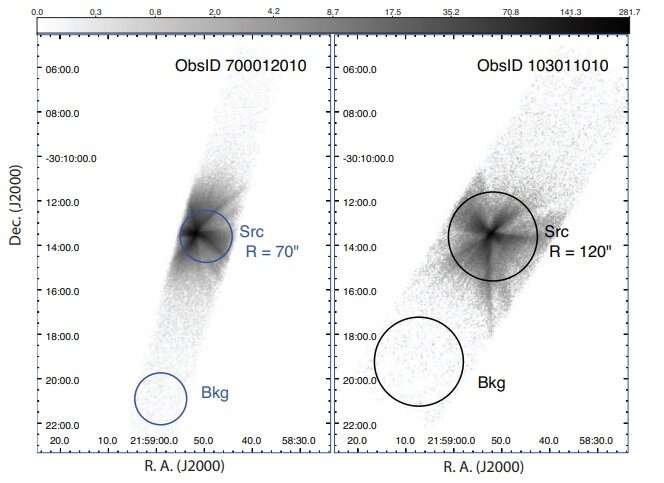January 25, 2021 report
Suzaku observations find X-ray intraday variability of the blazar PKS 2155−304

Using the Suzaku satellite, astronomers have examined a very high energy (VHE) blazar known as PKS 2155−304. They found that the source exhibits an X-ray intraday variability, which could improve the understanding of its nature. The finding is reported in a paper published January 15 on arXiv.org.
Blazars are very compact quasars associated with supermassive black holes at the centers of active, giant elliptical galaxies. Based on their optical emission properties, astronomers divide blazars into two classes: flat-spectrum radio quasars (FSRQs) that feature prominent and broad optical emission lines, and BL Lacertae objects (BL Lacs), which do not.
In general, blazars belong to a larger group of active galaxies that host active galactic nuclei (AGN), and their characteristic features are relativistic jets pointed almost exactly toward the Earth. However, the detailed mechanisms of ejection and collimation of jets are still poorly understood, and more studies of this phenomenon are required to improve our knowledge on the subject.
At a redshift of 0.116, PKS 2155−304 is a BL Lac and is the brightest object in the ultraviolet (UV) and X-ray bands in the southern hemisphere. Given that a VHE gamma-ray emission has been detected from this source, it is classified as a TeV blazar. PKS 2155−304 has been observed on many occasions by various X-ray missions and some studies reported the detection of X-ray variability of this object.
Recently, a team of astronomers led by Zhongli Zhang of the Shanghai Astronomical Observatory in China, has conducted a detailed investigation of PKS 2155−304 in order to shed more light on its X-ray emission and variability. The study is based on Suzaku spacecraft data obtained between 2005 and 2014.
"We have examined 13 pointed observations of the TeV emitting high synchrotron peak blazar PKS 2155−304 taken by the Suzaku satellite throughout its operational period," the astronomers wrote in the paper. Suzaku light curves show that PKS 2155−304 exhibits large-amplitude intraday variabilities (IDVs) in the soft (0.8—1.5 keV) and the hard (1.5—8.0 keV) bands. The fractional variability turned out to be lower in soft band than in hard band. However, an opposite trend was observed in three Suzaku observations.
The astronomers found that in general, PKS 2155−304 exhibits a harder-when-brighter trend often seen in high-synchrotron blazars. The astronomers added that occasionally, the hardness ratio (HR) analysis showcases either a stable HR or a slightly softer-when-brighter trend. The results also indicate that the emissions in the soft and the hard bands are likely cospatial and emitted from the same population of leptons.
Moreover, the power spectral density (PSD) analyses of light curves found that they are red-noise dominated, with power-law spectral indices varying in a large range from −2.8 to −0.88. The results also suggest that the timescales for particle acceleration mechanisms dominate the variable emission of PKS 2155−304. The mass of the blazar's supermassive black hole was estimated to be around 340 million solar masses.
More information: X-ray Intraday Variability of the TeV Blazar PKS 2155-304 with Suzaku During 2005-2014, arXiv:2101.05977 [astro-ph.HE] arxiv.org/abs/2101.05977
© 2021 Science X Network





















